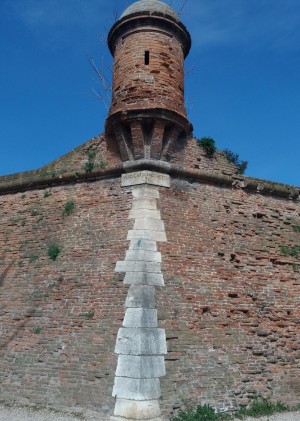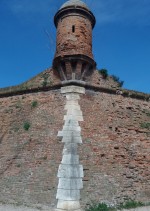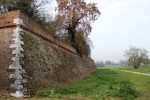The Barbacane or Baluardo di San Giorgio

La superstite guardiola cilindrica, unica testimonianza delle decine di garitte costruite nel corso del XVII e XVIII secolo lungo l'intero circuito fortificato della città
Built by the House of Este, the Baluardo San Giorgio was greatly modified and altered during architectural interventions over the ages, starting in the fifteenth century.
A bit of history
Since the end of the fourteenth century, the historical documentation contains references to a particular fortified structure that guarded the branch of the Po di Volano just after it forked near the village of San Giorgio: the Barbacane di San Giorgio (Barbican of San Giorgio), facing the village itself, where the church of the same name stands.
The term ‘barbican’ is derived from the medieval Latin barbacanis or from the Arabic vernacular bar-al-baqara, literally ‘livestock enclosure’, indicating a buttress or walled reinforcement designed for defensive purposes.
Between 1521 and 1525, Alfonso I d'Este ordered major modifications to the old structure, transforming it into a bastion equipped with embrasures to protect both the new Baluardo della Montagna and the fifteenth-century Porta di San Giorgio, which was also rebuilt in 1521. Subject to further works in 1557 by order of Duke Ercole II (with marble blocks placed at a slant along the edges), the bastion-barbican was partially destroyed in 1893 in order to create the toll barrier, before being torn apart once again between 1952 and 1958 to enable vehicle access to Via Ravenna.
The structure benefited from some repair work when Cardinal Giulio Sacchetti (1627-1630) was papal legate to Ferrara, as evidenced by the engraved marble quoin placed atop the eastern salient angle. The cylindrical watch tower above is the only evidence of the dozens of sentry boxes built during the 17th and 18th centuries right along the walls of the city.
Studies carried out in 1993 brought to light significant portions of the curtain walls and the foundations of the ancient Barbacane, which partially crumbled in that very year. The excavated ditches at street level and those of the outer walls of the structure have confirmed its separation from the Baluardo San Giorgio. In regards to the ramp and brick platform leaning against a very thick, dilapidated curtain wall (within the Barbacane), no iconographic references were found. The brick platform is placed at an elevation of 5.24 m, between the current street level (2.70 m) and the peak of the wall, which is at an elevation of 8.25 m. It therefore was not used to reach the top of the city walls (Bernardi-Pastore 2003, p. 143).
As part of the 2013 restoration and conservation of sections of the old walls, an ancient passageway through the wall face next to the Bagni Ducali building was reopened. By means of a paved ramp, it connected the wall with the terreplain on top pertaining to the residence built by Ercole II d’Este (based on drawings by Terzo Terzi) between 1541 and 1543. The new passageway can be added to the various ‘inside-outside’ connections found along the city walls near old doors or places where the wall was torn down over the last century to make way for various roads. Today, it is meant to encourage the recreational use of the green spaces along the city walls. Up until 2013, tourists and locals strolling along the upper earthwork on the ramparts would reach the Montagnola, then have no choice but to go back towards the Prospettiva di Corso Giovecca on Vial Alfonso I d’Este. With the opening of this new passageway, visitors can now descend within the wall and continue along the greenspace near the walls in the Quacchio quarter, or reach the tourist itinerary of the southern bastions by crossing Via San Maurelio at the intersection with Via Marco Polo.
Bibliography
- Francesco Scafuri, Le mura di Ferrara. Un itinerario attorno alla città, tra storia ed architettura militare, in Maria Rosaria Di Fabio (a cura di), Le mura di Ferrara. Storia di un restauro, Minerva, Bologna 2003
- Maurizio Bernardi, Michele Pastore, Il restauro delle Mura: gli interventi, in Maria Rosaria Di Fabio (a cura di), Le mura di Ferrara. Storia di un restauro, Minerva, Bologna 2003
Fototeca
Related Themes
Compiling entity
- Assessorato alla Cultura e al Turismo, Comune di Ferrara


